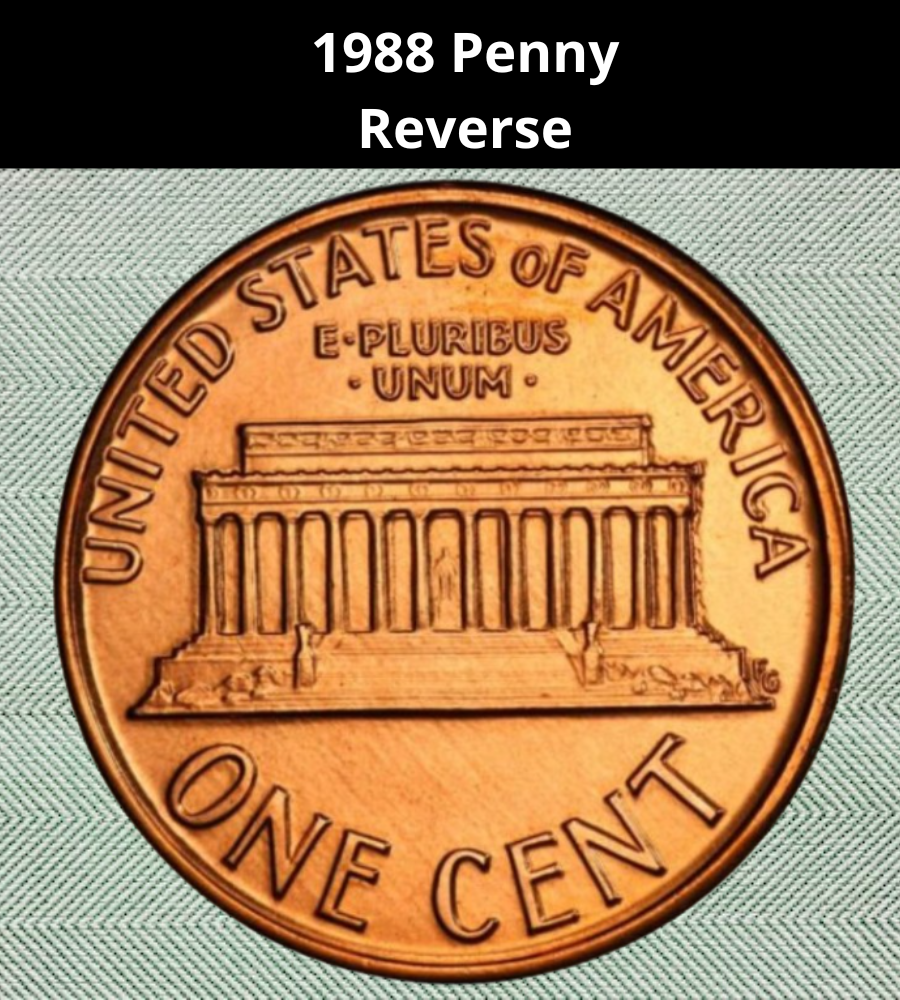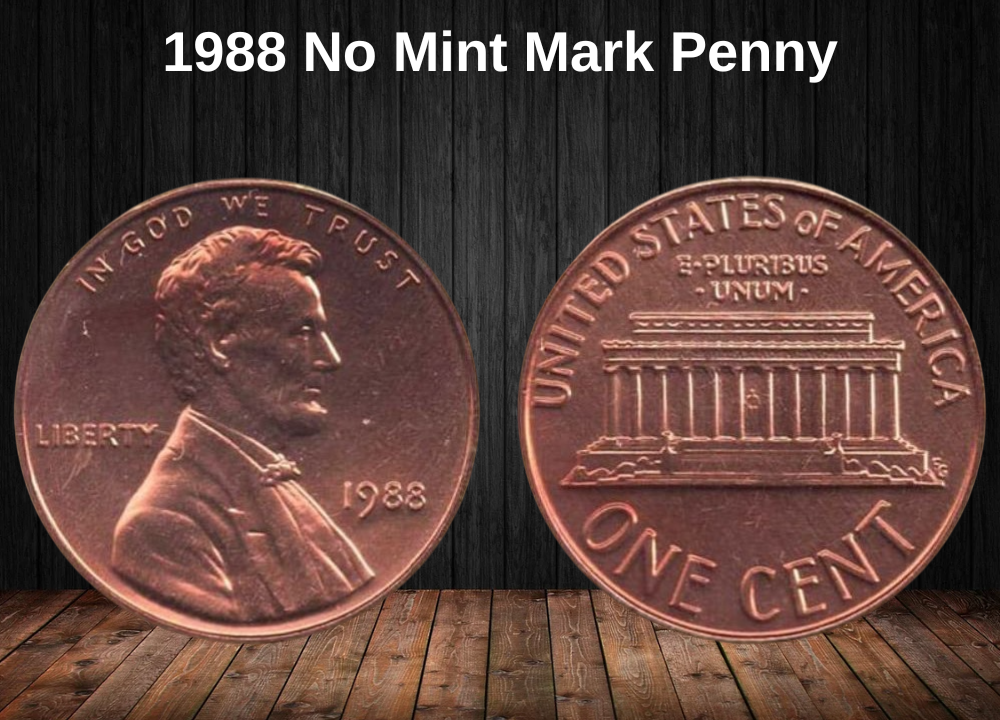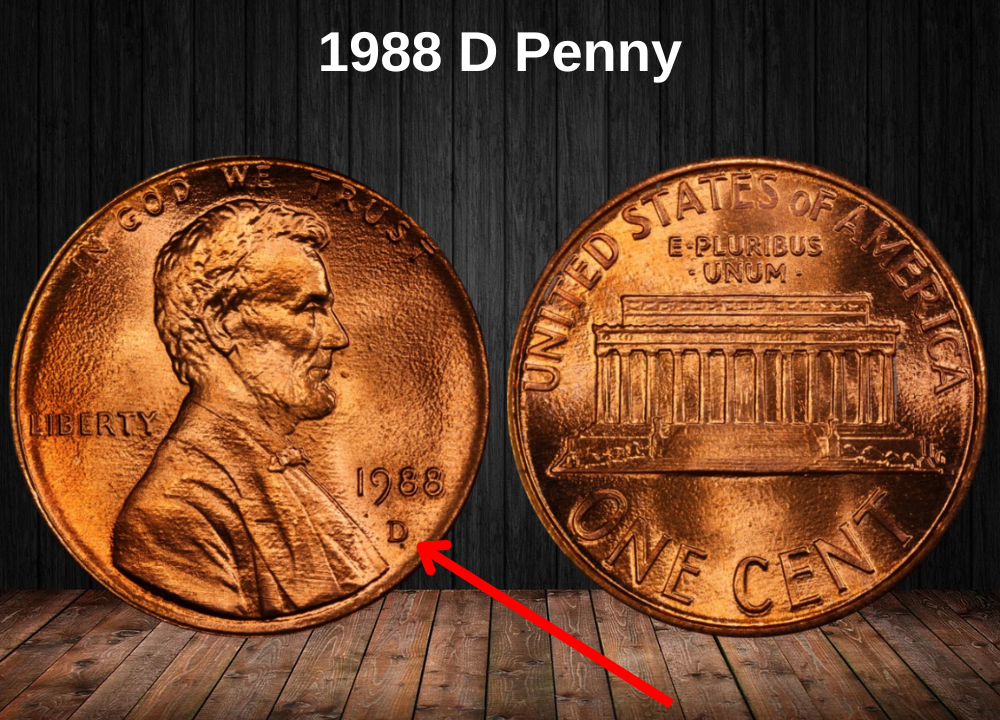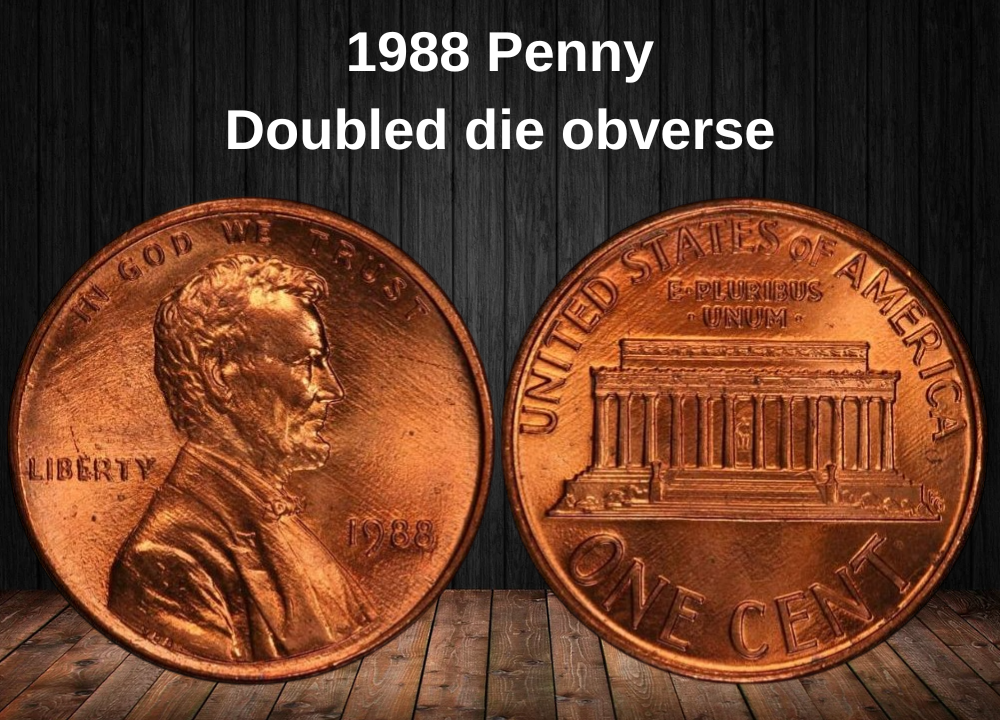The U.S. Mint produced an enormous quantity of 1988 Lincoln Memorial pennies, so finding one in your pocket change today isn’t unusual. In circulated condition, these coins typically carry no more than their face value—just one cent.
However, things change dramatically when it comes to uncirculated examples. If a 1988 penny is in pristine condition or displays a notable mint error, it could be worth hundreds or even over a thousand dollars, especially at higher mint state grades.
1988 Penny Value Chart
| Grade/Condition | 1988 (No Mint Mark) | 1988-D | 1988-S (Proof) |
|---|---|---|---|
| MS65 (Red) | $14 | $10 | – |
| PR65 (Proof Red) | – | – | $4 |
Note: Listed values apply to fully red coins, which are the most desirable among collectors.
History of the 1988 Penny

The U.S. Mint first introduced the Lincoln cent in 1909 to commemorate President Abraham Lincoln’s 100th birthday. Designed by Victor D. Brenner, the coin featured Lincoln’s portrait on the obverse and two wheat stalks on the reverse—a design that became affectionately known as the “Wheat Penny.”
This iconic design remained in circulation for 50 years. Then in 1959, to celebrate Lincoln’s 150th birthday, the reverse was updated to showcase the Lincoln Memorial, designed by Frank Gasparro. Notably, the memorial includes a tiny depiction of Lincoln’s seated statue between its central pillars—making this cent the first U.S. coin to depict the same historical figure on both sides.
1988 Lincoln Memorial Penny Types and Mintage
In 1988, the U.S. Mint struck an enormous number of Lincoln Memorial pennies across three facilities:
| Mint Location | Type | Mintage |
|---|---|---|
| Philadelphia | 1988 (no mint mark) | 6,092,810,000 |
| Denver | 1988-D | 5,345,467,111 |
| San Francisco | 1988-S (Proof) | 3,262,948 |
| Total | – | 11,441,540,059 |
Composition and Commonality
The 1988 penny belongs to the Lincoln Memorial series, but with a significant difference in its metallic composition. In 1982, rising copper prices led the Mint to switch from solid copper to a zinc core with a thin copper plating—a formula that continues to this day.
Because of their high mintage and modern composition, 1988 Memorial cents are widely available and generally inexpensive, especially in circulated condition. However, uncirculated specimens, rare errors, or proof coins can still be of interest to collectors.
Features of the 1988 Penny
The obverse of the 1988 Penny

The obverse of the 1988 penny features the familiar portrait of Abraham Lincoln, originally crafted by Victor David Brenner. Inspired by an earlier plaque he created showing Lincoln reading to a child, Brenner adapted this artwork for use on the nation’s smallest denomination coin.
However, many numismatic experts believe Brenner may have also drawn influence from one of Mathew B. Brady’s famous photographs of Lincoln. Regardless of the inspiration, his initials—VDB—can be found subtly inscribed just beneath Lincoln’s right shoulder on the coin.
Surrounding Lincoln’s profile are standard inscriptions:
- “IN GOD WE TRUST” arches above his head near the rim,
- “LIBERTY” appears to the left near Lincoln’s neck,
- The date, 1988, is placed to the right, just in front of his chest.
If there’s a mint mark, it appears directly beneath the year:
- “D” indicates the Denver Mint,
- “S” identifies a proof coin struck in San Francisco,
- Coins struck in Philadelphia bear no mint mark.
The reverse of the 1988 Penny

The reverse of the 1988 Lincoln penny was designed by Frank Gasparro, a longtime U.S. Mint engraver, and introduced in 1959 to commemorate the 150th anniversary of Abraham Lincoln’s birth.
At the center of the reverse is a detailed depiction of the Lincoln Memorial, located in Washington, D.C. If you look closely between the two central columns, you’ll notice a tiny bust of Lincoln seated inside—an impressive feature given the small scale. This subtle detail makes the Lincoln cent unique, as it portrays the same figure on both sides of the coin.
Gasparro’s initials “FG” are inscribed in the lower right portion of the Memorial, near the base of the structure.
The inscriptions surrounding the design include:
- “UNITED STATES OF AMERICA” arching along the top rim,
- The motto “E PLURIBUS UNUM” just below that,
- And the denomination “ONE CENT” at the bottom center of the coin.
1988 Lincoln Memorial Penny Specifications
| Feature | Details |
|---|---|
| Face Value | One Cent ($0.01) |
| Diameter | 0.750 inches (19.05 mm) |
| Thickness | 0.039 inches (1.0 mm) |
| Weight | 0.088 ounces (2.5 grams) |
| Composition | 97.5% Zinc, 2.5% Copper (copper-plated zinc) |
| Edge Type | Plain |
| Shape | Round |
The 1988 penny was struck on a copper-plated zinc planchet, a composition introduced in 1982 as a cost-saving measure due to rising copper prices. This change remains in place to this day.
Additional Details About the 1988 Penny
The 1988 Lincoln penny is round with a smooth, plain edge and carries a face value of one cent. It was struck on a copper-plated zinc planchet, consisting of 97.5% zinc and 2.5% copper—a composition that the U.S. Mint began using in 1982 to reduce production costs.
Each coin measures 0.750 inches (19.05 mm) in diameter, has a thickness of 0.039 inches (1.0 mm), and weighs exactly 2.5 grams (0.088 ounces).
Despite its modest appearance, this penny carries over a century of American history in its design and materials.
1988 Penny Grading Overview
If you’re trying to figure out how much your 1988 penny is worth, getting it professionally graded is a crucial step. Grading evaluates several aspects of a coin’s condition, including the presence of scratches, corrosion, surface marks, holes, and overall wear. Luster, die quality, and strike sharpness are also key factors.
Wear and tear play a big role in grading. Coins showing heavy signs of use usually receive the lowest grades and are often not of interest to collectors. On the flip side, coins that have never been in circulation and retain their original brilliance can earn the highest grades—and bring in the best prices.
Here’s a simplified breakdown of the grading scale:
| Grade Level | Description |
|---|---|
| 1 | Basal State |
| 2 | Fair |
| 3 | Very Fair |
| 4–6 | Good |
| 7–10 | Very Good |
| 12–15 | Fine |
| 20–30 | Very Fine |
| 40 | Extremely Fine |
| 50 | About Uncirculated |
| 60 | Mint State (Uncirculated) |
| 65 | Choice Mint State |
| 70 | Perfect Mint State |
Checking a grading guide before selling or buying is essential—it helps you pinpoint the coin’s condition and determine its true market value.
1988 Penny Value Guides
1988 No Mint Mark Penny Value

In 1988, the Philadelphia Mint produced a staggering 6,092,810,000 Lincoln Memorial pennies—so it’s no surprise that these coins are still extremely common today.
Even in uncirculated condition, most examples are quite affordable. However, red (RD) coins in higher Mint State grades can carry a bit more value due to their pristine color and luster.
Here’s a breakdown of their approximate market value based on grade (for red specimens):
| Grade (RD) | Estimated Value |
|---|---|
| MS63 | $6 |
| MS64 | $10 |
| MS65 | $14 |
| MS66 | $24 |
| MS67 | $50 |
| MS68 | $275 |
Auction Highlight:
The most valuable example of a 1988 Philly penny sold for $7,040 in May 2021 on eBay. This coin was graded MS69 Red, an exceptionally rare condition for this high-mintage year.
1988 D Penny Value

In 1988, the Denver Mint had a massive output, striking 5,345,467,111 Lincoln Memorial cents. Thanks to this high mintage, most of these coins are still easy to find in circulation—and generally, they’re not particularly valuable unless in top condition.
For uncirculated examples (grades MS60–MS63), values range between $0.10 and $0.50. However, coins with a red (RD) designation and higher grades can be worth more to collectors due to their preserved luster and eye appeal.
Estimated Value by Grade (Red Specimens):
| Grade (RD) | Estimated Value |
|---|---|
| MS64 | $7 |
| MS65 | $10 |
| MS66 | $16 |
| MS67 | $36 |
| MS68 | $300 |
Auction Highlight:
An impressive 1988-D red penny graded MS68 fetched $1,495 at a Heritage Auction in June 2007—a reflection of just how rare flawless high-grade specimens can be.
1988 S Proof Penny Value

In 1988, the San Francisco Mint produced 3,262,948 proof Lincoln Memorial cents, specially struck for collectors. These coins feature a sharp strike, mirror-like fields, and frosted design elements—especially desirable in Deep Cameo (DCAM) condition.
Despite their attractive appearance, most 1988-S proof pennies are relatively affordable due to their high mintage and the use of aging dies during production.
Estimated Value by Grade (Red DCAM Specimens):
| Grade (PR/DCAM) | Estimated Value |
|---|---|
| PR60–PR63 | $1–$2 |
| PR64 | $3 |
| PR65–PR66 | $4–$5 |
| PR69 | $14 |
Auction Highlight:
A flawless PR70 DCAM 1988-S Lincoln proof penny sold for $1,438 at Heritage Auctions in July 2004, showing that top-tier examples still attract serious interest.
Rare 1988 Penny Errors List
1988 P and D Penny with the reverse of 1989
Some Lincoln cents minted in 1988—both from Philadelphia (no mint mark) and Denver (D mint mark)—feature a transitional error caused by pairing the 1988 obverse with a reverse die intended for 1989 coins.
This type of minting mistake is known as a transitional design error, and it occurred when the U.S. Mint accidentally (or possibly through oversight) used new reverse dies for 1989 during the 1988 production run.
How to Spot the Error:
The primary visual clue lies in the designer’s initials “FG” (Frank Gasparro), located near the base of the Lincoln Memorial on the reverse.
- On standard 1988 cents, the “G” in “FG” is thicker and more rounded.
- On the transitional error coins, the “G” is noticeably thinner, with:
- A shorter upper curve
- A horizontal hook extending from the lower part
- A visible vertical bar below the body of the letter
This version of the “G” was used starting in 1989, so finding it on a 1988 coin confirms the transitional mistake.
Value & Rarity:
- 1988-D transitional reverse pennies are especially rare and command higher premiums among collectors.
- 1988 no-mintmark (Philadelphia) transitional examples are more common but still sought after.
- Values vary by condition, but well-preserved examples can fetch hundreds of dollars, with top-tier specimens selling for even more.
Doubled die obverse

In 1988, both the Philadelphia and Denver mints produced Lincoln cents with doubled die obverse (DDO) errors—mistakes that occur when the coin’s die receives a misaligned impression from the hub, creating noticeable doubling on design elements.
Denver Mint (1988-D) DDO:
- The doubling is most often seen in the date, especially on the number “9”.
- Look closely at the tail and upper loop of the “9” for signs of doubling.
Philadelphia Mint (1988) Doubled Ear:
- The Philadelphia issue has a distinctive error known as the “Doubled Ear”, where Lincoln’s ear appears doubled due to the die anomaly.
- This particular DDO variety is very popular among collectors because the doubling is clear and dramatic.
Value of 1988 DDO Pennies:
- A red (RD) 1988 Doubled Ear penny in MS66 grade sold for $3,120 at a Heritage Auctions sale in 2020.
- Lower-grade or brown examples will command less, but high-grade red DDOs can still bring in hundreds to thousands of dollars, depending on condition and eye appeal.
Re-punched mint mark
In 1988, the U.S. Mint was still applying mint marks manually, a process that involved punching the letter (D for Denver) directly into the working dies by hand. This manual approach often resulted in misalignments, especially when the punch had to be reapplied—leading to what collectors call a Re-Punched Mint Mark (RPM) error.
What Causes an RPM Error?
- Sometimes, the first strike of the mint mark was misaligned, too shallow, or off-center.
- The mint worker would then attempt to reposition and re-punch the mark correctly.
- This process occasionally left behind multiple impressions of the mint mark, with parts of the original mark still visible beneath the final one.
1988-D RPM Pennies:
- The 1988-D Lincoln cents are known for featuring this error.
- You may see a shadow-like doubling or a clear overlap of two or more “D” marks on the obverse, just below the date.
Collector Appeal:
- RPM errors are highly collectible, especially when the doubling is clear.
- Depending on the clarity and grade, a 1988-D RPM penny can be worth $25 to $125 or more.
Where to sell your penny?
Now that you know the value of your penny, you might be wondering where to sell it. Don’t worry: here’s a guide to some of the best online platforms where you can easily sell your coins, along with their advantages and disadvantages.
Discover the best platforms for selling coins online (pros and cons).
FAQ about the 1988 Penny
1. What is the significance of the 1988 penny in relation to transitional design changes on the Lincoln Memorial reverse?
The 1988 Lincoln cent is notable because it precedes a major design change in 1989, when the “G” in “FG” (Frank Gasparro’s initials) on the reverse was repositioned. This makes transitional design features on 1988 cents — such as subtle differences in the spacing or style of the designer’s initials — of interest to variety specialists.
2. Are there any known transitional errors involving the 1988 penny?
Yes — one of the most famous is the 1988-D Reverse of 1989 variety. This rare error occurs when a 1988 Denver penny was struck using a 1989 reverse die, which has a different design of the FG initials. These coins are extremely collectible and command strong premiums in all grades.
3. How can a collector tell the difference between a normal 1988-D and the rare Reverse of 1989 variety?
The key is to examine the “FG” initials on the reverse:
- On the normal 1988-D, the G has a serif (a small tail).
- On the Reverse of 1989, the G is plain (sans-serif) and sits closer to the Lincoln Memorial.
Magnification and comparison with known examples are essential for confirmation.
4. How did the minting technology in 1988 impact the quality and consistency of Lincoln cents that year?
By 1988, the U.S. Mint had refined its use of zinc planchets with copper plating, leading to more uniform strikes and fewer plating blisters compared to earlier years. However, coins were still vulnerable to “zinc rot” if stored improperly.
5. Are there significant differences in strike quality between 1988 Philadelphia and Denver pennies?
Generally, Denver (D) minted coins have stronger strikes and clearer details, while Philadelphia (no mint mark) coins may show more weakness in areas like Lincoln’s cheek or the Memorial steps. This was due to die wear and maintenance differences between the mints.
6. What are the best methods to identify high-grade 1988 pennies worth slabbing or grading?
Focus on:
- Full strike details on Lincoln’s hair and beard.
- Sharp Memorial steps and no signs of wear on high points.
- Original mint luster with minimal spotting.
Coins graded MS-67 and above can be valuable, especially with red color designation (RD).
7. Why do most 1988 pennies have little value in circulated condition, and what makes specific examples valuable?
1988 pennies are common in circulation, but rarities like the Reverse of 1989 variety, high MS grades, and errors (off-center, double strikes, die clashes) can raise their value dramatically. It’s these outliers that collectors chase.


















































